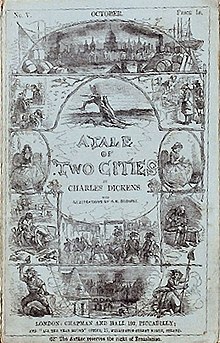A Tale of Two Cities

Cover of serial Vol. V, 1859
|
|
| Author | Charles Dickens |
|---|---|
| Illustrator | Hablot Knight Browne (Phiz) |
| Cover artist | Hablot Knight Browne (Phiz) |
| Country | United Kingdom |
| Language | English |
| Genre | Historical novel |
| Published | 1859 |
| Publisher | London: Chapman & Hall |
| Pages | 341 Pages (Paperback) |
| Preceded by | Little Dorrit (1855–1857) |
| Followed by | Great Expectations (1860–1861) |
A Tale of Two Cities (1859) is a novel by Charles Dickens, set in London and Paris before and during the French Revolution. The novel depicts the plight of the French peasantry demoralized by the French in the years leading up to the revolution, the corresponding brutality demonstrated by the revolutionaries toward the former in the early years of the revolution, and many unflattering social parallels with life in London during the same period.
Dickens's famous opening sentence introduces the universal approach of the book, the French Revolution, and the drama depicted within:
It was the best of times, it was the worst of times, it was the age of wisdom, it was the age of foolishness, it was the epoch of belief, it was the epoch of incredulity, it was the season of Light, it was the season of Darkness, it was the spring of hope, it was the winter of despair, we had everything before us, we had nothing before us, we were all going direct to Heaven, we were all going direct the other way—in short, the period was so far like the present period, that some of its noisiest authorities insisted on its being received, for good or for evil, in the superlative degree of comparison only.
In 1775, a man flags down the nightly mail-coach on its route from London to Dover. The man is Jerry Cruncher, an employee of Tellson's Bank in London; he carries a message for Jarvis Lorry, a passenger and one of the bank's managers. Mr. Lorry sends Jerry back to deliver a cryptic response to the bank: "Recalled to Life." The message refers to Alexandre Manette, a French physician who has been released from the Bastille after an 18-year imprisonment. Once Mr. Lorry arrives in Dover, he meets with Dr. Manette's daughter Lucie and her governess, Miss Pross. Lucie has believed her father to be dead, and faints at the news that he is alive; Mr. Lorry takes her to France to reunite with him.
In the Paris neighborhood of Saint Antoine, Dr. Manette has been given lodgings by his former servant Ernest Defarge and his wife Therese, owners of a wine shop. Mr. Lorry and Lucie find him in a small garret, where he spends much of his time making shoes—a skill he learned in prison, which he uses to distract himself from his thoughts, and which has become an obsession for him. He does not recognize Lucie at first but does eventually see the resemblance to her mother through her blue eyes and long golden hair, a strand of which he found on his sleeve when he was imprisoned. Mr. Lorry and Lucie take him back to England.
...
Wikipedia
